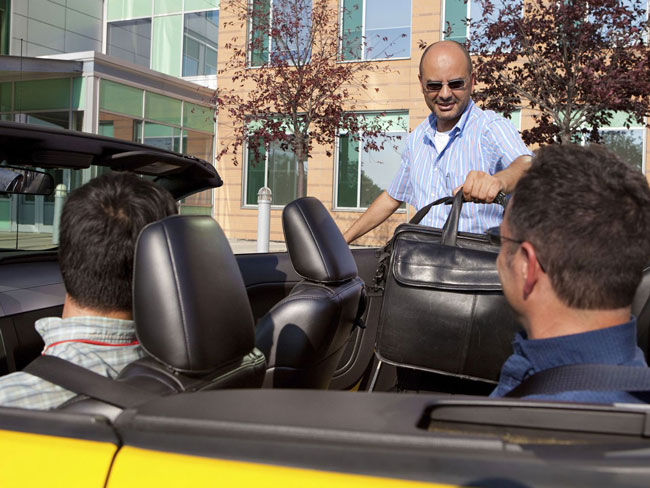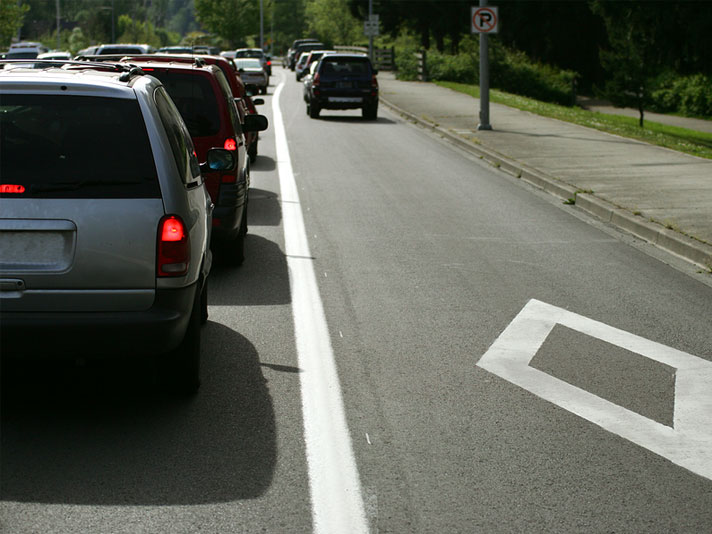How Office Carpooling Benefits Your Wallet, Work-Life Balance, and the Planet
- By Miriam Wolf
- Reading Time: 4 mins.

Hey, you there—driving to work all by yourself with only those wacky Z-100 DJs to keep you company. Aren’t you lonely? Wouldn’t you like to save some money and help the environment? Achieving those goals can be as simple as reducing your solo car commute time by carpooling.
Long before Uber and Lyft made ridesharing a for-profit enterprise, there was the carpool. Beloved by both office workers and soccer moms, the carpool brings together people with similar destinations to save time, gas, money, and the environment.
Departments of transportation across the country have set up various structures to support people sharing rides and carpooling. There are, of course, the ubiquitous freeway carpool lanes to speed the trips of cars containing more than one person.
But access to carpool lanes is not the only perk offered to carpoolers. There are some real money-saving measures out there including preferential or reduced-rate parking costs and even cold, hard cash for gas money.
How to Start an Office Carpool?
The easiest and most basic way to start a work carpool is to take a look at the other people in your office. Talk to your colleagues. Is someone coming from the same neighborhood as you? Do they share your work hours? Before I became a committed bike commuter, I used to carpool with a coworker, who, in an office of only a dozen people in a major metropolitan area, miraculously lived less than a mile from me. Larger companies may offer employee incentives to carpoolers and may even help pair people up for commuting purposes. Ask your HR representative.

If your office offers no possibilities, the next place to turn is 511. 511 is a nationwide road and transportation hotline originally organized by the Federal Highway Administration. Dial 511 and it provides phone service for road conditions, but in many locations, it also offers one-stop travel and transit information. 511.org shows real-time road conditions and trip planning services. To find support for carpooling commuters, including, in many locations, a computerized matching service for ride givers and ride takers, try searching the site for 511 + your city or state.
Oregon’s Get There Oregon website, which matches up carpoolers, offers these common-sense tips for hammering out negotiations between riders and drivers:
- Meet unknown prospective carpooler(s) at a public place such as a coffee shop to discuss details and ensure you are compatible.
- Set guidelines ahead of time to avoid misunderstandings. Discuss preferences for music, heating and air conditioning, eating and drinking in the car.
- Determine your route, schedule, pickup points, and other details.
- Drivers may alternate or elect one person to drive while others cover gas and expenses.
- Agree on a way to get in touch with each other.
- Set a date to start carpooling. Do a trial run for a week to make sure it works for everyone in the carpool.
- Decide how the expenses (gas, tolls) will be divided.
- Agree on how long drivers should wait at a stop for late passengers before leaving.
- What is the backup plan if the set driver is ill, oversleeps, or has mechanical problems?
Negotiating agreements in advance is important, especially if carpoolers are matched through a service and don’t previously know each other.
Casual Fridays (and Other Days)
But maybe a standardized carpool with rules and a rigid timetable just isn’t your bag. In the San Francisco Bay Area, Washington DC, and Houston, a culture has grown up around casual carpooling. Casual carpooling sounds a bit like hitchhiking: Riders line up in designated areas; sometimes they are local businesses, sometimes specific locations set up by an area’s transit authority (in Oakland near the Bay Bridge on-ramps, for example).
Drivers cruise by and pick them up, dropping off at either a standardized location or a mutually agreed-upon place. It’s the ultimate quid-pro-quo: passengers get a ride into town, drivers get to drive in the high-occupancy vehicle or carpool lane.
Jill Olson, a bass player for the band Red Meat, lives in Oakland and has been using casual carpooling for years to get to her day job in San Francisco. “As long as we’re at the carpool spot by 9 or 9:15 a.m., we always get a ride. Sometimes we drive and pick up people. Once we drove our band van and picked up six carpoolers!”
Jodi Levin, who lives in Berkeley, has also taken casual carpools across the Bay Bridge. She notes that there is a rigid protocol around carpooling. “It’s weird,” she says, “you’re not supposed to talk.”
Jill Olson agrees. “The radio is usually turned to NPR, and there is no talking in the car. That’s fine by me. Those are the unofficial carpool rules.” She also points out that it’s customary to give the driver a dollar for gas.
Other nice habits for both drivers and passengers to have when sharing a ride is to be aware that some people are sensitive to fragrances. If you wear perfume, it might be best to apply it at the office rather than before the morning commute. It also goes without saying those open containers of coffee and/or eating breakfast in your ride-sharing partner’s car is frowned upon.
Commuters, unite! Pair up, double down, or go for the triple—carpooling can get you where you need to go with an added dose of thrift and environmental consciousness.
This article was originally published on March 25, 2015, by Miriam Wolf. It was updated by The FruitGuys on March 18, 2025.


